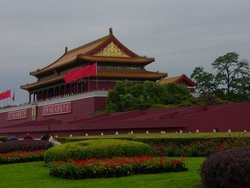Tiananmen
|
|
The Tiananmen or Tian'anmen (Template:Zh-stpl), is the principal entrance to the Imperial Palace Grounds, commonly called the Forbidden City, in Beijing, People's Republic of China. It is located along the northern edge of Tiananmen Square.
The gate was originally named Chengtianmen (Template:Zh-stpl). The gate was damaged by lightning in 1457, and was not repaired until 1465. It suffered another blow in the war at the end of Ming Dynasty. In 1644 during the Qing Dynasty, the gate was again burnt down by rebels led by Li Zicheng. Like other official buildings of the empire the gate has unique imperial roof decorations. It has the highest number of figures on the roof ridges - ten in each set.
In front of the gate are two lions standing in front of the gate and two more guarding the bridges. Two stone columns -- each with an animal (hou) on top of it -- also stand in front of the gate. They apparently were there to keep an eye out on the emperor inside the Forbidden City; the animal facing outside (south) would admonish the emperor if he stayed out for too long. Meanwhile, the animal facing inside (north) would reprimand an emperor who stayed inside the realms of the Forbidden City for too long.
The central gate has a portrait of Mao Zedong towering over it, while the western and eastern walls have giant placards; the left one reads "Long Live the People's Republic of China" (中华人民共和国万岁), while the right one reads "Long live the Great Unity of the World's Peoples" (世界人民大团结万岁). The right placard used to read "Long Live the Central People's Government", and both placards used to be written in traditional Chinese instead of simplified Chinese characters. The phrasing has great symbolic meaning, as the phrase used for long live, like the palace itself, was traditionally reserved for Emperors of China, but is now available to the common people.
The reviewing stands in the foreground are used on International Workers Day (May Day) and on the National Day (October 1) of the People's Republic of China.
In front of the stands is the palace moat, still filled with water but now containing decorative illuminated fountains.
When proceeding northward through the palace grounds, the next gate encountered is the 'Upright Gate', identical in design to the Tiananmen; behind it is the southern entrance of the Forbidden City itself, known as the Meridian Gate.
The Tiananmen is featured on the emblem of the People's Republic of China.de:Tor des himmlischen Friedens es:Puerta de Tiananmen zh:天安门


